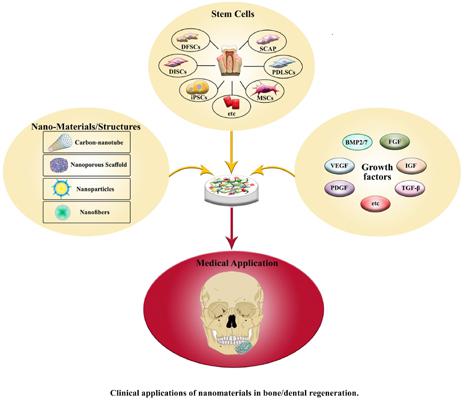Mini-Reviews in Medicinal Chemistry ( IF 3.8 ) Pub Date : 2021-03-31 , DOI: 10.2174/1389557520666201124143449 Mohsen Yazdanian 1 , Aghil Rahmani 2 , Elahe Tahmasebi 1 , Hamid Tebyanian 1 , Alireza Yazdanian 3 , Seyed Ali Mosaddad 4

|
In modern dentistry, nanomaterials have strengthened their foothold among tissue engineering strategies for treating bone and dental defects due to a variety of reasons, including trauma and tumors. Besides their finest physiochemical features, the biomimetic characteristics of nanomaterials promote cell growth and stimulate tissue regeneration. The single units of these chemical substances are small-sized particles, usually between 1 to 100 nm, in an unbound state. This unbound state allows particles to constitute aggregates with one or more external dimensions and provide a high surface area. Nanomaterials have brought advances in regenerative dentistry from the laboratory to clinical practice. They are particularly used for creating novel biomimetic nanostructures for cell regeneration, targeted treatment, diagnostics, imaging, and the production of dental materials. In regenerative dentistry, nanostructured matrices and scaffolds help control cell differentiation better. Nanomaterials recapitulate the natural dental architecture and structure and form functional tissues better compared to the conventional autologous and allogenic tissues or alloplastic materials. The reason is that novel nanostructures provide an improved platform for supporting and regulating cell proliferation, differentiation, and migration. In restorative dentistry, nanomaterials are widely used in constructing nanocomposite resins, bonding agents, endodontic sealants, coating materials, and bioceramics. They are also used for making daily dental hygiene products such as mouth rinses. The present article classifies nanostructures and nanocarriers in addition to reviewing their design and applications for bone and dental regeneration.
中文翻译:

当前和先进的牙科纳米材料作为再生剂:更新
在现代牙科中,纳米材料在组织工程策略中加强了其立足点,用于治疗由于各种原因(包括外伤和肿瘤)引起的骨骼和牙齿缺陷。除了它们最好的物理化学特征外,纳米材料的仿生特性还促进细胞生长并刺激组织再生。这些化学物质的单个单元是小颗粒,通常在 1 到 100 nm 之间,处于未结合状态。这种未结合状态允许粒子构成具有一个或多个外部维度的聚集体并提供高表面积。纳米材料为再生牙科带来了从实验室到临床实践的进步。它们特别用于创造用于细胞再生、靶向治疗、诊断、成像、以及牙科材料的生产。在再生牙科中,纳米结构的基质和支架有助于更好地控制细胞分化。与传统的自体和同种异体组织或同种异体材料相比,纳米材料重现了天然牙齿结构和结构,并更好地形成了功能组织。原因是新型纳米结构为支持和调节细胞增殖、分化和迁移提供了一个改进的平台。在修复牙科中,纳米材料广泛用于构建纳米复合树脂、粘合剂、牙髓密封剂、涂层材料和生物陶瓷。它们还用于制造日常口腔卫生产品,例如漱口水。



























 京公网安备 11010802027423号
京公网安备 11010802027423号